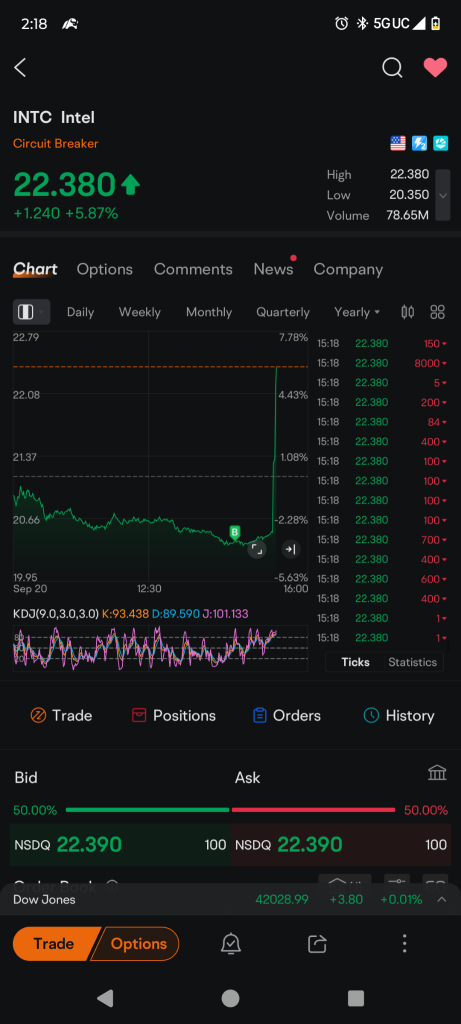什么状况
liked
As the saying goes, bears don't die and bulls don't stop !!! Here's a reminder for everyone 👀 The current U.S. stock market has experienced a two-year bull market. Individual stock values have risen almost to their peak. At this historical high, the large cap is still bouncing up in a jumping manner.![]() I think it's abnormal. Everyone needs to be aware that the large cap can also drop sharply. Especially today, looking at qualcomm, which originally had good performance but its trend gives a negative feeling. Just a personal opinion. I hope everyone will be a bit more cautious.
I think it's abnormal. Everyone needs to be aware that the large cap can also drop sharply. Especially today, looking at qualcomm, which originally had good performance but its trend gives a negative feeling. Just a personal opinion. I hope everyone will be a bit more cautious.![]()
![]()
![]()
$E-mini NASDAQ 100 Futures(DEC4) (NQmain.US)$
$E-mini NASDAQ 100 Futures(DEC4) (NQmain.US)$
Translated
5
1
什么状况
liked
$NVIDIA (NVDA.US)$ Can i get a $120 please , anyone , anyone bueler, bueler, going once going twice Sold to the Bulls!!
3
什么状况
liked
$NVIDIA (NVDA.US)$ Are many people selling TSLA to buy this?
Translated
3
2
什么状况
liked
Good afternoon, traders. Happy Thursday, July 25th. The market is turning sideways, but big tech is climbing back up after dropping Wednesday: earnings season is hurting stock gains enjoyed so far this year.
My name is Kevin Travers, here are stories from the herd on Wall St today.
$Ford Motor (F.US)$ stock is moving 18% lower on Thursday after the company missed analyst EPS estimates for the 2024 fiscal year's second quarter. The co...
My name is Kevin Travers, here are stories from the herd on Wall St today.
$Ford Motor (F.US)$ stock is moving 18% lower on Thursday after the company missed analyst EPS estimates for the 2024 fiscal year's second quarter. The co...

37
10
2
什么状况
liked
 Expand
Expand 20
1
5
什么状况
liked
$Tesla (TSLA.US)$
The stock price has started to adjust downward, it is advisable to take profits while it's still good. At least 3 days of adjustment, and if a bit more, it will be 5 days. It is a technical adjustment.
The stock price has started to adjust downward, it is advisable to take profits while it's still good. At least 3 days of adjustment, and if a bit more, it will be 5 days. It is a technical adjustment.
Translated
1
什么状况
liked
$NASDAQ 100 Index (.NDX.US)$ Economic Observer reporter Liang Ji observes that inflation pressure remains unabated, and monetary tightening continues. The recent monetary policy meeting minutes released by the central banks of USA and Europe reiterated their commitment to tightening monetary policy to curb inflation.
On November 23, 2022, local time, the Federal Reserve (Fed) released the minutes of its November interest rate meeting. It revealed that the Fed will continue to raise interest rates, but at a slower pace, and begin to consider a policy shift after an economic recession. The market expects the Fed to raise rates by the anticipated 50 basis points (BP) in December, marking a possible end to aggressive rate hikes.
On the other side of the Atlantic Ocean, the European Central Bank's message on rate hikes appears firm. On November 24, local time, the European Central Bank released the minutes of its October monetary policy meeting. It showed that member countries unanimously agreed that given the current inflation outlook, loose policies should be removed to normalize monetary policy and ensure that demand no longer remains unchecked. The market expects the European Central Bank to further raise interest rates to prevent the risk of inflation expectations derailing.
Amid continued tightening of monetary policies in Europe and the USA, the market is beginning to focus on the signals reflecting economic recession. In November, the PMI of the USA and Europe both fell into the contraction range. The turning point of the US monetary policy may not have arrived yet, and the Federal Reserve may continue to raise interest rates to 5%, which would increase the risk of economic downturn. The trend towards 'stagflation-style' recession in 2023 is a high probability event; China International Capital Corporation believes that, despite the slight cooling in US October CPI inflation, most Fed officials remain cautious and advocate for further interest rate hikes, with a relatively firm attitude. Some officials even warn the market not to overly interpret inflation data. One reason is the limited error tolerance of the Federal Reserve, and the other is that monthly inflation data is not enough to entirely reassure the Federal Reserve.
On November 23, 2022, local time, the Federal Reserve (Fed) released the minutes of its November interest rate meeting. It revealed that the Fed will continue to raise interest rates, but at a slower pace, and begin to consider a policy shift after an economic recession. The market expects the Fed to raise rates by the anticipated 50 basis points (BP) in December, marking a possible end to aggressive rate hikes.
On the other side of the Atlantic Ocean, the European Central Bank's message on rate hikes appears firm. On November 24, local time, the European Central Bank released the minutes of its October monetary policy meeting. It showed that member countries unanimously agreed that given the current inflation outlook, loose policies should be removed to normalize monetary policy and ensure that demand no longer remains unchecked. The market expects the European Central Bank to further raise interest rates to prevent the risk of inflation expectations derailing.
Amid continued tightening of monetary policies in Europe and the USA, the market is beginning to focus on the signals reflecting economic recession. In November, the PMI of the USA and Europe both fell into the contraction range. The turning point of the US monetary policy may not have arrived yet, and the Federal Reserve may continue to raise interest rates to 5%, which would increase the risk of economic downturn. The trend towards 'stagflation-style' recession in 2023 is a high probability event; China International Capital Corporation believes that, despite the slight cooling in US October CPI inflation, most Fed officials remain cautious and advocate for further interest rate hikes, with a relatively firm attitude. Some officials even warn the market not to overly interpret inflation data. One reason is the limited error tolerance of the Federal Reserve, and the other is that monthly inflation data is not enough to entirely reassure the Federal Reserve.
Translated
3



![[empty]](https://static.moomoo.com/node_futunn_nnq/assets/images/folder.5c37692712.png)
![[error]](https://static.moomoo.com/node_futunn_nnq/assets/images/no-network.991ae8055c.png)